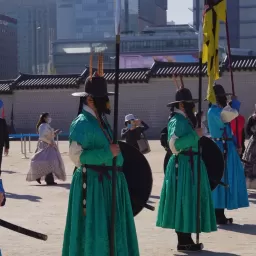Language And Writing
The Korean writing system is called Hangeul (also spelled Hangul), and it is known for its unique and efficient design.
 Bonus: Korean Culture:
Korean culture is a blend of tradition and modernity, preserving its heritage while embracing contemporary influences. Let’s learn more about it.
Bonus: Korean Culture:
Korean culture is a blend of tradition and modernity, preserving its heritage while embracing contemporary influences. Let’s learn more about it.
The Korean writing system is called Hangeul (also spelled Hangul), and it is known for its unique and efficient design. Created in the 15th century by King Sejong the Great and his scholars, Hangeul was designed to be easy to learn and accessible to the common people. Here are some key features of the Korean writing system:
-
Phonetic Nature: Hangeul is a phonetic script, which means that each character represents a sound. The script is composed of 14 basic consonants and 10 basic vowels, and these can be combined to form syllables. The shapes of the characters are based on the articulatory features of the sounds they represent, making it logical and systematic.
-
Syllabic Blocks: Instead of writing each letter individually, Hangeul characters are combined into syllabic blocks. Each block represents one syllable, typically consisting of a consonant and a vowel. If a syllable begins with a vowel, the consonant is represented by an empty circle.
-
Alphabet Size: Compared to many other writing systems, Hangeul has a relatively small number of characters, making it more accessible for beginners. The basic set of characters can be easily learned, and additional characters are formed through combinations.
-
Left-to-Right and Top-to-Bottom Writing: Hangeul is written horizontally from left to right, similar to English. However, each syllabic block is arranged vertically from top to bottom within the horizontal line. This combination of left-to-right and top-to-bottom orientation is distinct from some other East Asian writing systems.
-
Modern Usage: Hangeul is the official writing system of both North and South Korea. It is used in various media, including books, newspapers, websites, and official documents. While many Koreans are also familiar with the Chinese characters (Hanja), they are used less frequently in modern Korean writing.
-
Computer Compatibility: Hangeul is well-suited for digital communication, and typing in Korean is straightforward on computers and smartphones. Input methods often involve typing the phonetic sound of the word in the Roman alphabet and then selecting the desired Hangeul characters.
Overall, Hangeul is celebrated for its simplicity, logical design, and effectiveness in representing the Korean language. It has played a crucial role in promoting literacy and communication among the Korean people